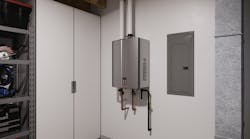Latest from Hydronics
Sponsored
By Tim Greer
Tankless water heater technology has been labeled with many misconceptions over the years. One myth that often comes up when installing a tankless water heater is the need to upgrade your gas line. When installing a tankless water heater, the appliance must receive the appropriate amount of supply to function properly; however, you don’t always need to upgrade the gas supply line to achieve the right level of fuel, and here’s why.
Origin of the Myth
Tankless water heater technology began to significantly impact the North American market around the 1990s. During this time, standard tanks were the preferred method of heating water due to its compatibility with the current gas supply, and the tanks’ capability to utilize a lower amount of fuel, as the standard tank heats water slowly with a smaller flame, commonly around 40-80K Btu.
With the rise in popularity of tankless water heaters, larger supply lines were required to accommodate the higher gas volume needed to sufficiently fuel a tankless unit. Early tankless technology was designed with minimum gas pressure requirements as high as 6 to 8 in. w.c. (inches of water column), depending on the gas type (LP/NG). The reason for the higher requirements is tankless technology heats water much quicker due to a larger flame, commonly 120-199K Btu, but the units only use fuel when hot water is called for and in direct relation to the amount of hot water demanded. Where a 50K Btu standard tank always uses 50K Btu, virtually at all times of the day and night, a tankless may only use 15K Btu for low flow rates, like a single faucet. If several fixtures are in use with a tankless (and if groundwater is cooler), the gas line must be sized to accommodate the maximum Btu.
Without upgrading the gas distribution system, the supply in some homes could be inadequate and the tankless unit’s advanced safety technology could opt to shut down with a flame-related error code, leaving the end user without hot water.
But within the last 10 years, tankless technology has evolved. Now, tankless water heaters can operate at a much lower gas pressure than in the past. One example is Rinnai’s Sensei Condensing Models, which is designed to adjust for less-than-optimal gas pressure, allowing for supply as low as 3-1/2 in. w.c. With tankless technology improvements, accounting for lower gas pressure, homeowners or installers do not always have to worry about taking that extra step of updating a supply line when installing a tankless water heater.
Advancement in Technology
Allowing a lower input gas pressure in tankless technology is important, as the infrastructure of some major cities only delivers low levels to residential homes, often receiving around 7 in. w.c. to provide a safe delivery. And on top of hot water requirements, a home’s gas system must also provide fuel to furnaces, stoves, dryers and even fireplaces.
Advancements in technology have allowed installers of tankless water heaters to possibly forgo upsizing the supply line, eliminating the need for modification. For example, Rinnai’s Sensei Model uses a zero governor gas valve with a customized switching venturi and turbo fan. These components work together to provide the ideal mixture of gas and air to produce energy-efficient combustion. This updated technology is more forgiving for applications of low gas pressure.
So instead of a low gas supply lockout and error code because the tankless water heaters’ minimum gas pressure is lower, you have more pressure drop available to achieve longer distance with a smaller gas line diameter. It is also important to note that Rinnai, as with most gas appliance manufacturers, will always recommend that installers be trained on and follow their national, state/provincial, and local gas code requirements to ensure safe and proper operation.
Installation Affordability
The myth of having to upgrade your gas line when installing a tankless unit has caused many customers to reconsider a tankless water heater, as adjusting a supply line could be costly to undertake. According to homeguide.com, modifying a new line to increase supply could cost anywhere from $500 to $2,000 depending on the distance from the meter. On average, the installation ranges from $12 to $25 per linear foot to upgrade the supply. But with many tankless water heaters now compatible with lower gas pressure situations, you can safely say to your customers that they can skip the hefty cost of updating the supply line. And you’ll be able to provide exactly what the customer wants at a reasonable, affordable installation price.
If you or your customers are waffling on whether to install a tankless unit due to a low gas pressure issue, in many cases, no alteration is needed, making the installation of a tankless affordable to your customers. Having to modify gas lines isn’t the only myth associated with tankless water heaters. If you would like to learn more about other common misconceptions associated with the technology, visit www.rinnai.us/tanklesstruths.
Tim Greer is a technical training developer and instructor with Rinnai America. With over 20 years in the mechanical and electronics industries, he began his journey with Rinnai over 16 years ago. He has held various roles in technical support, commercial service, product management and training development.


